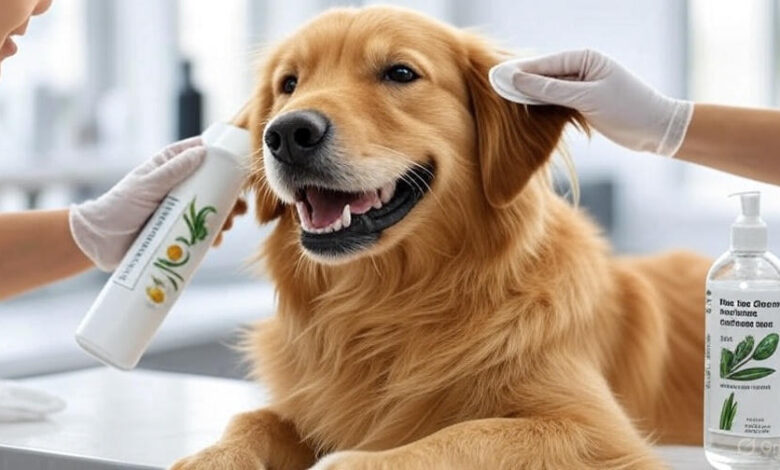Home Remedies for Dog Ear Infections
Best Ear Cleaning Solution for Dogs with yeast infection

Ear infections are one of the most common health issues that bring dogs to the veterinarian. If you’ve ever watched your dog scratch relentlessly at their ears, shake their head nonstop, or whimper when you touch the area, you know how uncomfortable an ear infection can be.
This guide covers safe home remedies for dog ear infections, signs you should never ignore, and practical tips for prevention—while helping you understand when to call a vet for a dog ear infection.
Understanding Dog Ear Infections
Canine ear infections usually involve bacteria, yeast, or sometimes both. Breeds with floppy ears (like Cocker Spaniels or Golden Retrievers) and dogs that swim often are more prone because moisture and limited airflow create the perfect environment for microorganisms to grow.
Common Symptoms
- Persistent ear scratching or pawing
- Head shaking or tilting
- Redness or swelling inside the ear canal
- Dark discharge or foul odor
- Sensitivity or pain when the ear is touched
If you notice these signs, your dog may have otitis externa (outer ear infection). Inner or middle ear infections can cause more serious symptoms like loss of balance or hearing problems and need veterinary attention quickly.
When to See a Veterinarian First
Before trying any home treatment for dog ear infection, it’s essential to know when professional help is required:
- Severe pain or swelling
- Bloody or pus-like discharge
- Fever, lethargy, or loss of appetite
- Symptoms lasting more than 2–3 days or worsening despite home care
A vet can examine the ear canal with an otoscope and may run cytology tests to identify whether bacteria, yeast, or mites are present. This is critical, because using the wrong home remedy can make the infection worse.
Safe Home Remedies for Mild Ear Infections in Dogs
If your vet confirms a mild infection or recommends at-home care, the following natural remedies for dog ear infections can help soothe irritation and support healing.
Gentle Ear Cleaning with Vet-Approved Solutions
The first step in most home care plans is cleaning. Use only a veterinarian-approved ear cleaner—not hydrogen peroxide or alcohol, which can damage sensitive tissue.
How to clean dog ears at home:
-
- Lift the ear flap and fill the ear canal with the recommended solution.
- Gently massage the base of the ear for 20–30 seconds.
- Let your dog shake their head, then wipe away debris with a soft cotton ball (never a Q-tip).
Warm Compress for Discomfort
A simple warm (not hot) compress can reduce pain and loosen waxy buildup. Hold a clean, warm cloth against the ear flap for a few minutes twice daily.
Natural Soothing Agents (With Vet Approval)
Some natural ingredients have mild antimicrobial or anti-inflammatory properties, but always check with your vet first.
- Aloe vera gel (pure, without alcohol) can calm itching on the ear flap.
- A green tea rinse (cooled, unsweetened) may gently reduce inflammation.
Important: Avoid essential oils like tea tree or oregano—they can be toxic to dogs.
Probiotic Support
Because yeast overgrowth often accompanies ear infections, adding dog-safe probiotics to the diet may help rebalance gut and skin microbiota, supporting the immune system from within.
What Not to Use in a Dog’s Ear
Many well-meaning pet owners reach for pantry staples, but some popular internet suggestions are unsafe:
- Hydrogen peroxide: Can irritate and delay healing.
- Apple cider vinegar: Too acidic for inflamed tissue.
- Rubbing alcohol: Dries and burns sensitive skin.
These can worsen discomfort or push infection deeper.
Preventing Future Ear Infections
Preventive care is the best home remedy. Regular ear maintenance lowers the risk of recurrent infections, especially in dogs with allergies or floppy ears.
Regular Cleaning
- Clean weekly for breeds like Labradors or after every swim.
- Use a veterinarian-recommended ear flush to remove excess wax and moisture.
Keep Ears Dry
- Dry ears thoroughly after baths or swimming.
- Consider drying solutions formulated for dogs prone to swimmer’s ear infections.
Manage Allergies
Food or environmental allergies often trigger chronic ear inflammation.
- Work with your vet on an elimination diet or allergy testing if infections keep coming back.
Balanced Diet & Supplements
A nutrient-rich diet with omega-3 fatty acids supports skin health and reduces inflammation, helping the ear canal stay resilient.
- Natural home remedies for dog ear infection
- How to treat dog ear yeast infection at home
- Safe ear cleaning solution for dogs
- Dog ear infection symptoms and treatment
- When to see a vet for dog ear infection
- Prevent recurrent ear infections in dogs
Quick Home-Care Checklist
- ✅ Assess severity first—if unsure, call the vet.
- ✅ Clean gently with a vet-approved solution.
- ✅ Provide comfort with warm compresses.
- ✅ Support immunity with a balanced diet & probiotics.
- ❌ Avoid harsh chemicals like hydrogen peroxide or alcohol.
- ❌ Don’t delay professional care if symptoms persist.
The Bottom Line
Mild canine ear infections can sometimes be managed at home with vet-guided cleaning and soothing natural remedies, but there’s a fine line between safe DIY care and risking your dog’s health.
- Use only veterinarian-approved ear cleaners.
- Avoid harsh ingredients or essential oils.
- Contact your vet promptly if you see worsening signs, pain, or discharge.
By combining safe home remedies with preventive care, you can keep your dog’s ears healthy and free of infection—while ensuring you know exactly when to call a vet for a dog ear infection.




